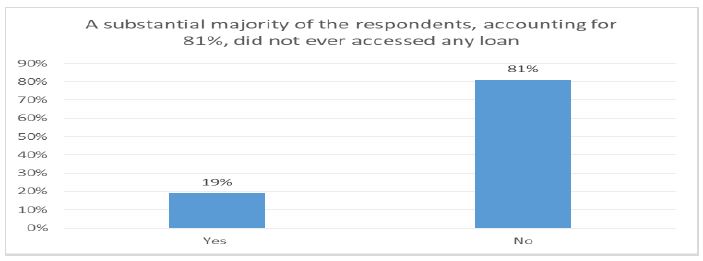A Study of the Factors that Affect Agribusiness Financing in Zambia (A Case Study of Smallholder Farmers in Chibombo District)
DOI:
https://doi.org/10.5281/zenodo.10934613Keywords:
agriculture financing, smallholder framers, agribusiness, gross domestic product (gdp), microfinanceAbstract
Limited access to agricultural financing is a constraint to the development of the Smallholder Farmers (SHFs) of the agriculture sector. This research aimed to address three fundamental objectives: the extent of financial inclusivity, the factors influencing access to finance, and the exploration of alternative financing models. A descriptive research design was employed which led to the adoption of a mixed-methods approach. A total of 100 out of 48,000 SHFs in Chibombo District were purposively sampled. The findings revealed that only 19% of SHFs surveyed reported having accessed credit and only 8% of rural SHFs were utilizing formal banking services. The study delved into credit access challenges, both on the demand and supply sides, results indicated that, the variables (gender, age, income) had weak statistically significant impact on the likelihood of borrowing money at the 0.05 significance level. However, it was noted that the p-values for gender and income were relatively close to the significance level indicating potential impact. In response to these challenges, the research proposed innovative financing models including mobile money lending, peer-to-peer lending, guarantee schemes, collateral substitutes and group lending. The study recommended that the Government and other stakeholders should strengthen technological infrastructure, develop and implement tailored financial education programs and encourage diversification of agriculture activities, and develop regulatory framework for mobile money lending to ensure consumer protection and fair competition.
Downloads
References
Baloyi JK. (2010). An analysis of constraints facing smallholder farmers in the agribusiness value chain: A case of farmers in Limpopo province. Masters Thesis, Unpublished. University of Pretoria, Pretoria.
Besley, Timothy, & Stephen Coate. (1995). Group lending, repayment incentives and social collateral. Journal of Development Economics, 46(1), 1-18.
Bidzakin KJ. (2009). Assessing performance of micro and small scale agribusiness in northern Ghana: Non-financial and stochastic frontier analysis. Masters Thesis, Unpublished. College of Agriculture and Natural Resources, Ghana.
Busetto, L., Wick, W., & Gumbinger, C. (2020). How to use and assess qualitative research methods. Neurol. Res. Pract. 2, 14. Available at: https://doi.org/10.1186/s42466-020-00059-z.
Central Statistical Office (Zambia). (2012). Zambia 2010 census of population and housing. National Analytical Report (Report No. HA4703 .A4 2010N). Central Statistical Office.
Chandio, A. A., Jiang, Y., Wei, F., Rehman, A., & Liu, D. (2017). Famers’ access to credit: Does collateral matter or cash flow matter?—Evidence from Sindh, Pakistan. Cogent Economics & Finance, 5(1), 1369383.
Churchill NC, & Lewis VL. (1983). The five stages of small business growth. Harvard Business Review, 61, 30-50.
Clover TA, & Darroch MAG. (2005). Owner’s perceptions of factors that constrain the survival and growth of small, medium and micro agribusinesses in KwaZulu-Natal, South Africa. Master’s Thesis, Unpublished.
Chipungu, S. (1988). The state, technology and peasant differentiation in Zambia: A case Study of southern province. Lusaka: Historical Association Of Zambia.
Chizuni, J.M. (1994). Food policies and food security in Zambia. Nordic Journal of African Studies, 3(1), 46-51.
Creswell, J.W. (2008). Understanding research. Michigan: University of Michigan.
Dodge, Doris Jansen. (1977). Agriculture policy and performance in Zambia.
Dorward, A., Kydd, J., Morrison, J., & Urey, I. (2004). A policy agenda for pro-poor agricultural growth. World Development, 32(1), 73-89.
EOSOC. (2016). Report of the inter-agency and expert group on sustainable development goal indicators, s.l.: ECOSOC.
Fatoki OO, & Garwe D. (2010). Obstacles to the growth of new smes in South Africa: A principal component analysis approach. African Journal of Business Management, 4, 729-738.
Hall G. (1995). Surviving and prospering in the small firm sector. London: Routledge.
Kuratko DF, & Hodgetts RM. (1995). Entrepreneurship: A contemporary approach. Orlando: The Dryden Press.
Ghosh, P., Mookherjee, D., & Ray, D. (2000). Credit rationing in developing countries: An overview of the theory. Readings in the Theory of Economic Development, 383-401.
Gloy, B. A., Gunderson, M. A., & LaDue, E. L. (2005). The costs and returns of agricultural credit delivery. American Journal of Agricultural Economics, 87(3), 703-716.
Green, E., & Norberg, M. (2018). Traditional landholding certificates in Zambia: Preventing or reinforcing commodification and inequality?. Journal of Southern African Studies, 44(4), 613-628. doi:10.1080/03057070.2018.1461490.
Govereh,J., T.S. Jayne., & A. Chapoto. (2008). Assessment of alternative maize trade and market policy interventions in Zambia. FSRP Working Paper No. 33. Lusaka, Zambia: Food Research Project.
Government of Republic of Zambia, (2004). Financial sector development plan. Lusaka: GRZ.
Green, E., & Norberg, M. (2018). Traditional landholding certificates in Zambia: Preventing or reinforcing commodification and inequality?. Journal of Southern African Studies, 44(4), 613-628. doi:10.1080/03057070.2018.1461490.
Hulme David, & Paul Mosley. (1996). Finance against poverty. London: Routledge.
Jayne T.S, B. Zulu., & B. Kajoba et al. (2008). Access to land and poverty reduction in rural Zambia: Connecting the policy issues. Food Security Research Project Working Paper No. 34. Lusaka, Zambia: FSRP.
Kalamata. (2009). Performance assessment of extension services under contract farming arrangement: A case study of flue-cured tobacco growers in Urambo district. Morogoro, Tanzania: Sokoine University of Agriculture.
Karli, A. B. (2009). Factors affecting farmers' decision to enter agricultural cooperatives using random utility model in the south eastern Anatolian region of Turkey. Journal of Agricultural and Rural Development in the Tropics and Subtropics, 107(2), 115-127.
Kelly, & Pemberton. (2016). An assessment of the Household food security status and local foods grown in rural Bahamas. The Journal of the Caribbean Agro-Economic Society, 8(1).
Kirsten, J. (2002). Linking agribusiness and small-scale farmers in developing countries: Is there a new role for contract farming?. Development Southern Africa, 19(4), 503-529.
Korie, G.K. (2015). Factors affecting access to credit by small business producer groups in Trans-Nzoia County. University of Nairobi.
Kothari, C.R. (2003). Research methodology: Methods and techniques. (2nd ed.). New Delhi: New Age International (P) Ltd Publishers.
Kothari and Garg. (2014). Research methodology methods and techniques. (3rded.). New Delhi: New Age International (P) Ltd., pp. 63.
Labaree, R. (2009). Research guides: organizing your social sciences research paper: Types of Research Designs.
Lawrence, M. K. (2010). Cooperatives: The sleeping economic and social giants in Uganda. Coop Africa Working Paper. No.5. ILO.
Meyer, R. L. (2011). Subsidies as an instrument in agriculture finance: A review.
Meyer, R. L. (2015). Financing agriculture and rural areas in sub-Saharan Africa: Progress, challenges and the way forward. IIED.
McGaghie et al. (2015, January 5). Problem statement, conceptual framework and research question. Retrieved from: Available at: http://goo.gl/qLIUFg.
Mugenda, & Mugenda. (2012). Research methods: Qualitative approaches. Nairobi: Africa Center for Technology Studies.
Mohn, P. (2007). Zambia: The enterprise development project. Africa region findings & good practice. World Bank, 1(1).
Njuguna, E., & Nyairo, N. (2010). Formal conditions that affect agricultural credit supply to small-scale farmers in rural Kenya: Case study for Kiambu County.
Nugussie, Z. (2009). Why some rural people become members of agricultural cooperatives while others do not. Ethiopia: Mekelle University.
Obwona. (2013). Determinants of technical efficiency differentials amongst small and medium-scale farmers in Uganda: A case of tobacco growers. AERC Research Paper 152. Nairobi: AFrican Economic Research Consortium.
Olomola I.O. (1999): Reading in agricultural financing small scale farmers in Nigeria. NISER publication.
Orodho. (2009). Techniques of writing research proposals and techniques. Nairobi: Harlifax printers.
Samboko, p., Sambo, J., & Luhana, J. (2008). Agriculture finance in Zambia: How can Smallholder Inclusion be Deepened. Working Paper No. 142, p. 56.
Sebatta, C., Wamulume, M., & Mwansakilwa, C. (2014). Determinants of smallholder farmers’ access to agricultural finance in Zambia. Journal of Agricutural Science, 6(11).
Siwale, M. (2019). Factors affecting access to finance by smallholder farmers in Zambia. Cape Town: University of Cape Town.
SPRS. (2014). International finance corp. 'AAA/A-1+' rating affirmed. Outlook Remains Stable, New York: McCRAW Hill Financial.
Susanne, N. et al. (2011). Agricultural development in a changing climate. s.l.: German Development Institute.
Stokes D, & Wilson, N. (2006). Small business management and entrepreneurship. South-Western Cengage Learning: DP Publications Ltd.
Tabachnick, B. G., & Fidell, L. S. (2007). Using multivariate statistics. Allyn & Bacon/Pearson Education.
Timmons J. (1999). New venture creation: Entrepreneurship for the 21st century. Boston: Irwin/McGraw-Hill.
Wachira, M. I., & Kihiu, E. N. (2012). Impact of financial literacy on access to financial services in Kenya. International Journal of Business and Social Science, 3(19).
Wenner, M. D. (2010). Credit risk management in financing agriculture. (No. 18(10)). International Food Policy Research Institute (IFPRI).
Wichern, R., Hausner, U., & Chiwele, D. K. (1999). Impediments to agricultural growth in Zambia (No. 47). International Food Policy Research Institute (IFPRI).
Zambia Statistics Agency. (2023). 2022 census of population and housing preliminary report. Zambia Statistics Agency. Available at: https://www.zamstats.gov.zm/wp-content/uploads/2023/05/2022-Census-of-Population-and-Housing-Preliminary.pdf.
Zambia Statistics Agency. (2023). Highlights of the 2022 poverty assessment in Zambia. Zambia Statistics Agency. Available at: https://www.zamstats.gov.zm/wp-content/uploads/2023/09/Highlights-of-the-2022-Poverty-Assessment-in-Zambia-2023.pdf.

Downloads
Published
How to Cite
Issue
Section
License
Copyright (c) 2024 Richard Chanda

This work is licensed under a Creative Commons Attribution 4.0 International License.
Research Articles in 'Management Journal for Advanced Research' are Open Access articles published under the Creative Commons CC BY License Creative Commons Attribution 4.0 International License http://creativecommons.org/licenses/by/4.0/. This license allows you to share – copy and redistribute the material in any medium or format. Adapt – remix, transform, and build upon the material for any purpose, even commercially.









